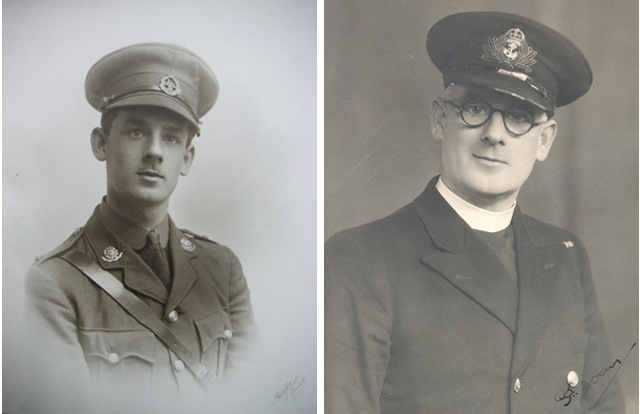
Told here for the first time, St. John Battersby's story almost defies belief. Born on 26th February 1900, Battersby was four weeks shy of his 15th birthday when he volunteered to join the ranks of the Manchester Regiment on 30th January 1915. With no chance of being accepted into the army at the age of 14, he declared himself to be 19 years of age, and employed as a draper. One wonders what his father Walter, vicar of Holy Trinity Church at Blackley, made of it all. In spite of his youth, Battersby had already been promoted to Lance Corporal by the time he was posted to the Manchester's 14th (Reserve) Battalion at Whittington Barracks, Lichfield on 13th March 1915. Within a month of his arrival at Lichfield, he had submitted his application for appointment to a commission. Supported by references from the Headmaster of the Grammar School at Middleton and - most impressively - David McCabe, Lord Mayor of Manchester, the application was approved, and on 6th May 1915 he was discharged from the Manchester Regiment on being appointed to a commission in the East Lancashire Regiment.  Left: St. John Battersby as an officer in the East Lancashire Regiment, aged 15; right: St. John Battersby as a chaplain in the Royal Navy Volunteer Reserve. Photographs by kind courtesy of St. John's son, Anthony Battersby. After serving almost twelve months with the 10th and 3rd (Reserve) Battalions of the East Lancashire Regiment, Battersby was posted to France on 18th April 1916; at the age of 16 years and 50 days, he would become the youngest officer in the British Army to serve on land in a Theatre of War. Some days later, he joined the 11th Battalion (Accrington Pals), then in Divisional Reserve at Bertrancourt. On 1st July 1916, Battersby led a platoon into the attack at Serre on the opening day of the Battle of the Somme. Fortunate to survive, he was hospitalized in England after suffering gunshot wounds to his right wrist and right thigh. As early as 23rd September, Battersby returned to France to re-join the 11th Battalion. On the night of 7th/8th March 1917, Y Company headquarters near Puisieux-au-Mont took a direct hit from an enemy shell. 2/Lt. Thomas Edgar Cronshaw from Blackburn was mortally wounded in the blast, while Battersby and Capt. Frederick Kite ("Fog") Dodson were both seriously wounded. Some three to four weeks later, Battersby's left leg was amputated at the upper thigh in an operation at No.1 General Hospital, Étretat. While convalescing at Devonport Military Hospital in November 1917, he received a letter from the War Office informing him that there was no alternative but that he should relinquish his commission "on account of ill-health, caused by wounds." Whereas most would have been glad to accept the decision without argument, the 17-year old Battersby replied that he would be getting an artificial limb "about Christmas", that he was "quite fit in every other way", and that he wished "to remain in until the end of the war." Battersby evidently won his battle with the authorities, and after being passed fit for office work on 13th March 1918, he joined the Royal Engineers (Transportation Branch) Record Office in Tavistock Square, London five days later. Battersby only relinquished his commission when he was demobilized on 20th September 1920, retaining the rank of Lieutenant. To the end of his army service, he maintained that his year of birth was 1896, though his Protection Certificate declared him to be a student, rather than a draper, in civil life. In the event, he was to join his father's vocation, and became vicar of Chittoe, near Devizes in 1933. During the Second World War, Battersby initially organized the Home Guard at Chittoe, and the vicarage became its logistical and administrative base. Later, he served in the Royal Navy and became the chaplain to the Royal Marines at Chatham, where he was made a lifetime honorary member of the Royal Marines Officers Mess. Finally demobilized in 1945, he returned to his parish at Chittoe. During the 1950s he was active in Civil Defence and was awarded the Civil Defence medal. © Andrew C Jackson 2004, 2013. Compiled from TNA documents WO339/34889, "The History of the East Lancashire Regiment in the Great War" edited by Major General Sir N. Nicholson, and with the kind help of St. John's son, Anthony Battersby.
|